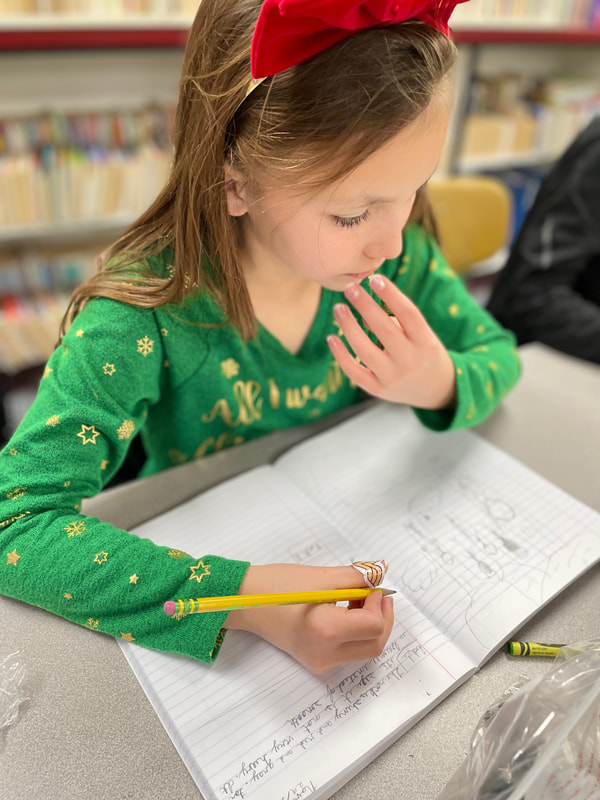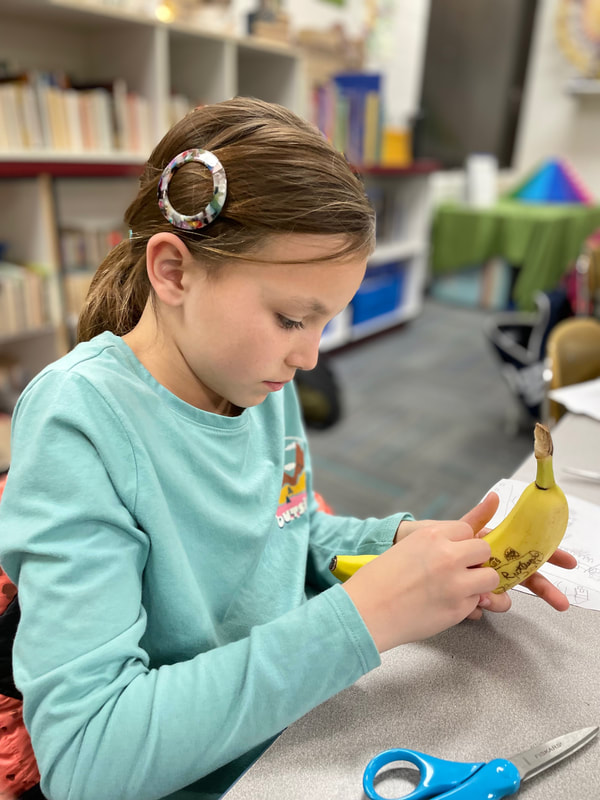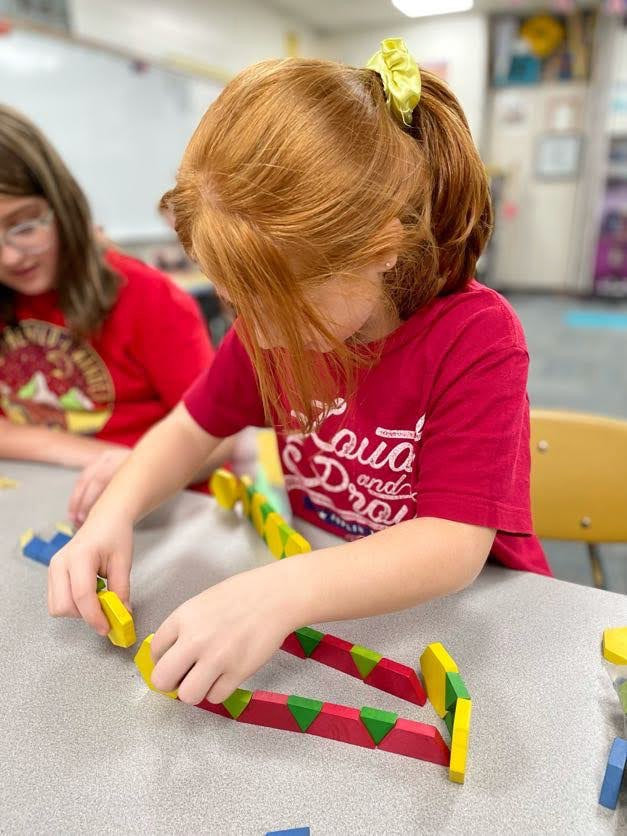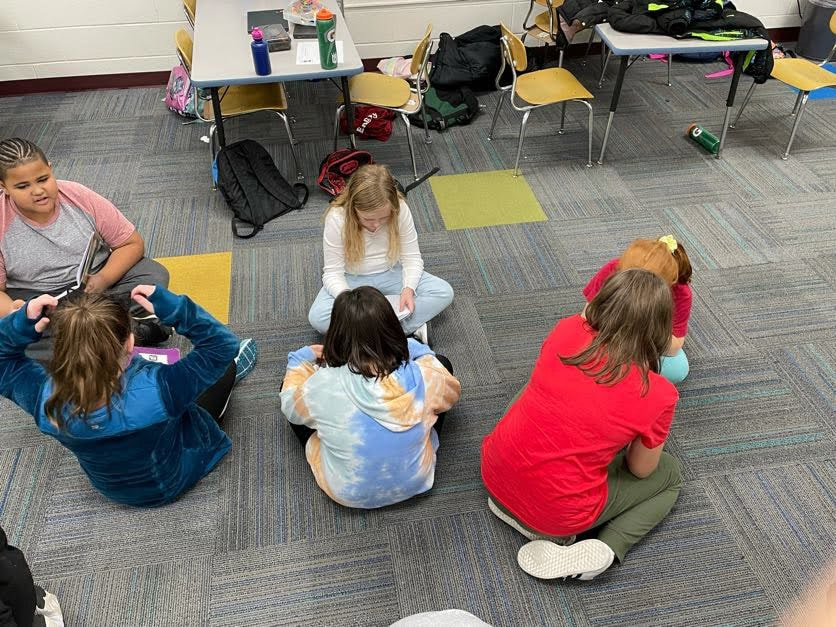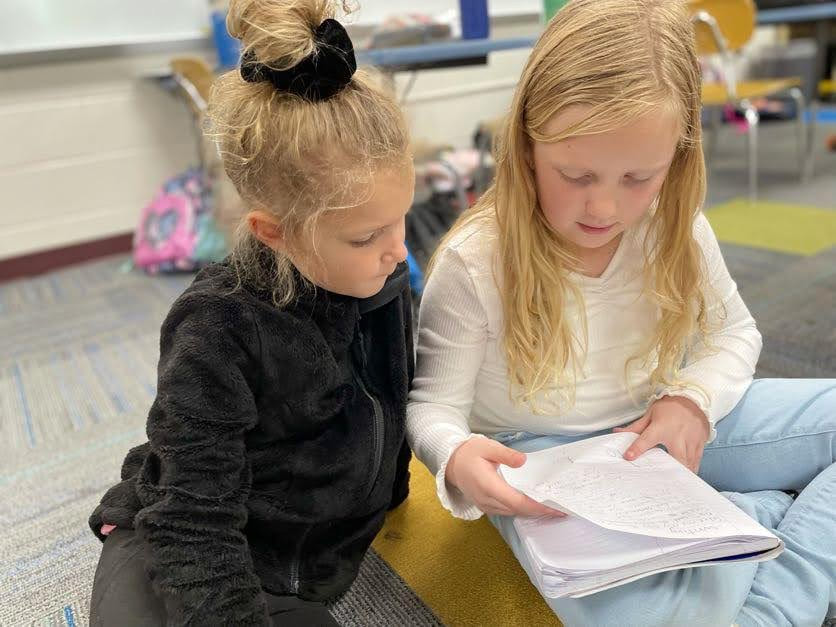|
Here are some shots of our first encounter with rocks in class. We kept things simple and just described three rock samples. Next stop: metamorphic, igneous, and sedimentary.
0 Comments
Here's another informative video about life at Fort Ticonderoga in the 18th century: When I visited Fort Ticonderoga in Upstate New York for a week-long teacher institute, I learned about Stephen Pell's experiences as a medic in World War I. One may think that to be strange - to visit an 18th century fort and hear something about the first world war - but there is a simple explanation. When Pell returned to the states, he discovered that the property with the old fort on Lake Champlain was in ruins. He was pivotal in beginning the first historical restoration project in the United States. The short video below shows the real Stephen Pell at the fort I love. I originally posted this six years ago, when our district was undergoing some much needed changes. Now, six years later, the pendulum appears to be swinging in the other direction again. Tighter curriculum, stricter schedules, and increased testing seem to be the current trend.  In the past several years, I've seen teachers struggling with a "curriculum" that was probably more rigid than rigorous. Now, with changes in leadership styles, Joplin teachers are being given some respect as professionals. And they don't like it. That's hyperbole, of course, but it gets your attention, doesn't it? Let me explain. For the past several years, administrators have expected classroom teachers to teach the same content at the same time with the same materials and the same methods. It was headed to the point that every classroom would look the same and feel the same. Every teacher would countenance the same expression on his/her face. I saw it coming. Any perfunctory glance at America's education system reveals it. Certain people's idea about equity and fairness is socialist at best. They expect the more prolific schools to be brought down to average because it's not fair that they are scoring higher and getting more positive publicity. That's hyperbolic only because it makes a point. Teachers across the nation have been treated like pawns in a malicious game set on turning kids into numbers and lines on graph paper. The science of teaching overrode every artistic aspect of the process, and teachers were/are turned into cookie cutter, robots, and algorithms. It's now possible, however, that changes are in the works. From the inside of the system, there is a fresh feel to the air. But some people don't understand it...and that's not an exaggeration. I've noticed some teachers that need to be weaned from the system we were in. While they went into it kicking and screaming, it's almost scary how fully they were sucked in. They were "spoiled" by the control others had over them. And now they don't know what to do. It's not their fault; as educators, we seek to please. As professionals, we put on positive faces and we make our schools look like they are chock-full of positive teams. We park straight in the parking lot. We walk into our buildings 15 minutes before we have to. And many of us take tons of work home with us every night. On weekends and holidays, we even take extra (just to keep ourselves busy - hey, it just might save us some of that drama that comes from conversing with our extended families!). We spend our summer vacations thinking, at every turn, "Hey, that would look good in the corner of my classroom," or "Hey, I bet I could work a unit around this experience." We dole out personal monies to pay for things that the school district won't provide. As the ad says, It's what we do." In short, for the most part, we walk the line. We want to do our best. We want to do things right and in accordance with the research we're being fed. So when something is handed to us, and words like curriculum and non-negotiable are used, be panic only briefly before picking it up and muddling through it. We have to do it, so we do it. And with that tight expectation to do everything to the letter, some of us have lost our creative focus. And with the loss of creativity and creative presentation, some of our students have lost their joy of learning. Dear educator, please don't be that teacher. Don't lose focus that it is still your classroom, that you are the professional in that classroom. How many times do we express that we want to be treated like professionals, that we want to be paid like professionals? How many times do we feel spat upon by our leaders in the legislature or some distant department of education? How often do we yearn for more autonomy. That's where we're trying to go in Joplin Schools. It's apparent in the way we see students taking responsibility for their learning, freeing teachers to present lessons in more creative ways and foster critical thinking. It's also apparent in the ways our curriculum is being presented to us - as a guideline and not as a "script". And that's why some are flailing. While students are required to become more responsible for their learning, teachers are now required to be more responsible for the ways in which curriculum is presented. It's not a totally new way to think about things. I've recognized for many years now that my classroom is different. It doesn't matter who is enrolled into my class, simply by being Hoggatteers, my class is different. You won't look through our window and find a cookie cutter or a robot; you look in there to find, hopefully, a teacher who does everything he can to make lessons unique. You'll find, hopefully, students who are having a good time in spite of their struggles and mistakes. In other words, this is my classroom. That doesn't mean I don't answer to supervision and expected standards. If you think about it, doesn't it make more sense than following a fixed script, a mass-marketed textbook, or whatever Bill Gates throws his money at. It means this is my classroom! These are my kids! Who knows my kids the best (besides their own families)? Not Bill Gates. Nay, I shall not wait for someone to hand me my cues. Teachers, let's not deny any opportunity that comes our way. As professionals, we must seize those opportunities and regain authority in our classes. We can only shine when we creatively think beyond the pattern that has been set before us. If we allow ourselves to be the same as everyone else, we have given up our humanity. It may be time to break away from the Bill-Gates-Common-Core-universal education system that has attempted to seize our careers and our children.
Last weekend, another student took a trip out of state, but on the way she stopped in St. Louis to visit our beloved "Gateway Arch", which marks a celebration point for Westward Expansion in the United States. She also walked across the street to the "Old Courthouse". The is the site of the infamous Dred and Harriet Scott Decision that left the enslaved couple under the ownership of their master.
As we often say, history is ugly, but it's always fun to hear that students are looking for history and excited to learn more. The mother of one of our afterschool History and Arts Group recently approached me to let me know that I have succeeded in getting her daughter to love colonial history. It must be contagious!  We hear, all the time, about how we should not stuff ourselves with food, whether junk food or just too much food in general. It is often on Thanksgiving that we begin thinking about our New Year's resolutions. We push ourselves away from the dinner table, and we stare at the empty dishes - coagulated bits of cranberry salad, sticky and charred marshmallow from the yams, turkey gristle - and we wonder if we could possibly be responsible for such carnage. We ponder our places in the world, in the grand scheme, and we wonder if there is something we might do, something we might say or do - or be - that will make the world a better place. Are we better people because we eat? Are we better when we diet? Are we healthier? Do we pass plates of positive possibilities to our children? If you really are what you eat, might I recommend a menu for this, and every, day?
In this restaurant, you aren't limited to one appetizer, one entree, and one dessert! Take liberally from every column, and leave feeling better than when you came in. In fact, eat everything in sight. You'll thank me for it. Your bill will reflect payment in full, because the only things you are required to pay are those parts of yourself that oppose what's on your plate. From the Hoggatteer family to yours, happy Thanksgiving!
Learn more about the Battle of Carillon and more about Fort Ticonderoga,
please see our lesson set on the subject, including this idea from the fort itself.
Thursday and Friday found the teacher in Columbia, Missouri, presenting professional development workshops to interested teachers from across the state. The arrangement of the schedule worked against us for Thursday afternoon's presentation. I had wanted to set up tables and reveal items for analysis, but because there was only fifteen minutes to set up, I had to punt and change the methods of presentation. Friday's presentation - Open-Ended Math and Language - drew a few participants early in the morning. This one felt well-received, with audience members making appropriate, on-subject comments and asking questions at the end. I always enjoy being able to present wisdom, ideas, and opinions with my peers from far and away, and I try to present methods and materials in which I specialize.
CB: What grade level do you teach? Have you always taught this grade level, or have you taught others? DH: I started teaching in 1995 (Do the math.). I taught first and second grades for five years in Oklahoma City before moving to Joplin, Missouri. I have since taught in my corner, fourth-grade classroom. At the end of this school year, that will be 27 years in Joplin and 32 years total (Check your work: was your subtraction correct?). I’ve been the Teacher of the Year for Joplin Schools and have received other awards for my performance in the classroom. I plan to find opportunities to continue supporting education. I would like to provide professional development to teachers and schools, work with new teachers and student teachers, and develop lessons and lesson sets. I just completed orientation with the Gilder Lehrman Institute of American History, headquartered in New York City, and hope to work with them on some incredible projects. My relationship with GLI comes as a result of being named Missouri’s 2021 History Teacher of the Year. CB: Do you teach a particular subject or all core subjects? DH: Yes. Actually, our teachers prefer to keep self-contained classes, so we teach all of the core subjects. In the past few years, I have developed my expertise in math and history (There aren’t many elementary teachers who can claim to specialize in history, so I’m pretty unique in that.). Working with history and art is a natural fit, and in my class we look at a lot of art from the colonial and revolutionary eras. From the beginning of my relationship with Crystal Bridges, I have pushed for a focus on art from the 17th and 18th centuries. CB: When did you first visit Crystal Bridges? DH: My son and my wife beat me to it. I think I finally got around to visiting in the summer of 2017, on a whim. It seems we were in the area for some other reason when we had a little extra time, and I suggested we visit Crystal Bridges. I was instantly impressed with the collection and presentation, and pressed forward with getting my peers to take a field trip during the following school year. During the summer of 2018, we all participated in a summer residency and teacher institute at the museum. CB: Tell us about your first summer residency at Crystal Bridges. How long were you there and what did you learn? DH: My grade-level teaching team entered a partnership with Crystal Bridges, and we were able to spend a week at the museum, in the summer 2018. We were quickly immersed in methods of interpreting art with students. On one day, we were able to highjack one of the museum educators (who would probably prefer to remain nameless) and take a private, extended tour of the museum. During that tour, we practiced some of the skills we had learned earlier in the week. The residency challenged us greatly in some unfamiliar territory. My own teaching was reinforced and affirmed during that week in Bentonville. I was already beginning to incorporate art in my history lessons, but now I had the tools to present it more effectively. It allows me to do so with academic rigor and more understanding than before. Every student in my class is now able to enter the conversation and add something vital to the lesson. Their observations and engagement with real art helps them understand the events of the era, the lifestyles of both the gentry and the common person. We now consider the enslaved, the natives, and the women of the era, in addition to more traditional stories and heroes in history. Using art as a stepping stone, we can connect multiple points of view to our present era, as well. CB: What other projects or partnerships have you been involved with since then (with Crystal Bridges)? DH: In the last 10 years, I have discovered the best professional development of my career. It started with the teacher institute at Crystal Bridges. During the same summer, I was accepted to the teacher institute at George Washington’s Mount Vernon. I stayed on the property at the Washington’s mansion and tomb for a week and studied General Washington at War. The following summer, I was one of 12 educators to travel to Fort Ticonderoga in Upstate New York. We spent a week discovering “America’s Fort” and the lifestyles of soldiers during the French and Indian War. We also compared and contrasted the French and Indian War with World War I. Art played a prominent role in each of these historic experiences, and I found what I had learned at the institute in Bentonville, Arkansas, to be quite helpful. Our partnership with Crystal Bridges has also continued since my first summer experience. We have hosted a museum educator in our classrooms for a week each year since, and we have taken our classes to the museum each year for field trips (virtually in the spring of our 2020/1 school year). Students have connected with the Crystal Bridges collection – appreciating the details, reacting emotionally with the art, writing about specific pieces in meaningful ways, and creating their own artwork in response. Others have visited for field trips, but our partnership has fostered a deeper connection with specific artwork and installations as well as museum staff and educators. CB: How many of your classes have experienced field trips at Crystal Bridges? DH: By my reckoning, five classes have attended field trips to the museum, but last year was a virtual presentation.
Students created their own Declaration and decorated a wall in our school with each student producing a single, colorful letter. During a different year, each class used paper shoestrings to make the letters in a different word (Our word was FREE.). Last year, our four classes collaborated on a short version of a Preamble, decorating and folding paper shoestrings to fill in the center of the project. CB: How have you been able to incorporate the lessons you learned at Crystal Bridges in your classroom? Can you give an example?
DH: My job as an educator is to get students engaged. When children are engaged with the content, they also bear some interest in it. I have learned not to “give” my class answers without first hearing about what they notice and what they wonder about a piece of art I present to them. They quickly learn that there is nothing too small to point out. They also make inferences by putting the information together and talking things out. In fact, I find myself teaching reading comprehension, literacy skills, and historical thinking by using art instead of text. In this way, they learn to think deeper even – even when they don’t read on grade level. The truth is, I use these same methods for math story problems, reading texts, science experiments, and history lessons. I use them with photographs, as well as primary documents and documentary videos. Students in my class can hold conversations on just about any subject, and they usually begin with art. CB: You have posters of artworks from Crystal Bridges hanging in your classroom. How have you found it beneficial to include these in your teaching? DH: I don’t want to sound repetitive, so let’s talk about the décor of my classroom. First, it changes throughout the year as we progress through history. I use many posters that include depictions of our founding documents, early surveys and maps of the colonial era, and art. Photographs do not exist from the 17th and 18th centuries, so art in many forms comes into play. Students can see the setting for many of the events, as well as fashion trends and the ways of life. Both the famous and the common man are depicted in the décor. Instead of laminated, cartoony posters with cute labels, I like to put classic art on my walls and bulletin boards. Students and their parents respond to this different setting. Our classroom boasts flags from a different time when appropriate to the study. Then, when we visit Crystal Bridges, students see things with which they are familiar. I like to think they react differently than classes that are not as familiar with the methods and the appearance of the museum – especially within the eras they have been studying. CB: Have you seen any changes in the way your students think or respond to class curriculum based on their interactions with Crystal Bridges? DH: My students now boldly step up with their observations and inferences. They are not scared to present their ideas about artwork or other items, and they learn how to disagree and ask questions to glean clarity from their classmates. They often find things that I haven’t considered, and they put details to work in their conclusions. They learn to “stay within the four corners” of a piece of art and to back up their conclusions with the observable facts presented by the artist. They cite the item before them instead of basing their conclusions on wild guesses or assumptions. This is rich – not just kids trying to repeat what the teacher has fed them, but kids getting their brains engaged and responding with civil discussion. That all sets the foundation for the rest of the lesson, and now that my pupils have safely entered the conversation, they can stay for the newest information and skills that I need to present to them. They are invested enough to desire more from me in the presentation, and they are more willing to put forth the effort necessary to perform tasks to accomplish their academic and social goals. We often take a break from the history to emphasize the drama games. This group really is experimental. In our first game, students paired up to play "The Force", where one person's hand had control over the other's face.
These are pictures of students putting together timelines for Fort William Henry, a little English fort nestled on the bank of Lake George in Upstate New York. This is the fort that was featured in The Last of the Mohicans.
Many teachers claim that their students can't think of anything about which to write. I never seemed to have that issue in my personal inspiration for writing, but I understand that some students do not have as many experiences as others, and as a result, they do not feel inspired. Others don't realize that they may create their own experiences to use for narratives or that they can begin with something bland and them embellish with excitement or tragedy. I enjoy providing students with experiences - the bigger and more chaotic the better sometimes - but in our everyday classroom, I have come to realize that sometimes an experience can be created out of the air. In Mood Music lessons, I play a preselected, instrumental piece of music and have the class sketch the image that comes to mind; it's as if they create a movie scene to match the music in the background.
Once the illustration is done, almost everyone is ready to write the scene that just played out in his or her imagination. They are thrilled to get to the writing piece, and some are even frustrated when they run out of time. We build some writing stamina in these moments, and they can't wait to share what they have created. As always, some are better than others, but improvement for all is our goal.
|
AnthemThe Hoggatteer Revolution
is an extensive, award-winning, inimitable, digital platform for Encouraging and Developing the Arts, Sciences, and honest Christianity in the beautiful, friendly LAND OF THE FREE AND THE HOME OF THE BRAVE This site is described as
"a fantastic site... chockablock full of interesting ideas, hilarious anecdotes, and useful resources." 
...to like, bookmark, pin,
tweet, and share about the site... and check in regularly for new material, posted often before DAWN'S EARLY LIGHT! History in ResidenceElementary Schools: Bring Mr. Hoggatt into your classroom for a week of engaging and rigorous history programming with your students. LEARN MORE BUILDING BETTER
|







